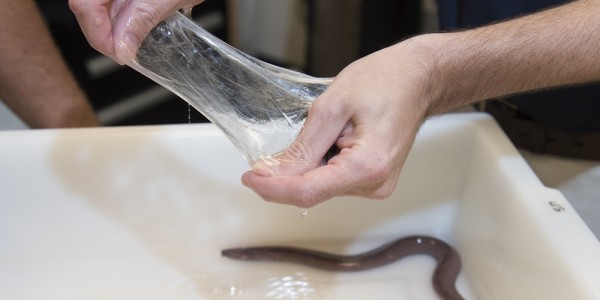

Navy researchers are looking in an unlikely place for new technology: at the bottom of the ocean where the hagfish lives. The reason the Navy is interested in the primitive eel-looking creature has to do with its defense mechanism: Slime.
The hagfish, often referred to as the slime eel, creates a slimy substance that rapidly expands under water and allows it to escape from predators by clogging its attacker’s gills. Think of an octopus’ ink, except this is a giant cloud of snot that chokes a predator. Disgusting, but effective.
It’s this slime that has the Navy’s interest because of what it might let them do.

Dr. Ryan Kincer demonstrates the elasticity of the hagfish slime secreted from the the Pacific hagfish within the net aboard Naval Surface Warfare Center Panama City Division (NSWC PCD) Nov. 29, 2016.U.S. Navy photo by Ron Newsome
According to the Virginian-Pilot, a research team in Panama City, Florida, has re-created the slime and now is working on turning it into something useable. Some of the ideas in the works include making a material that helps protect firefighters and divers, creating an anti-shark spray, or coating ships to protect against barnacles, algae, and other aquatic life.
Related: Bomb The Whales? Air Force Weapons-Test Plan Under Fire »
While the Navy tries to figure out what it’ll do with the slime, one problem they won’t have to deal with is how to replicate it, because as it turns out it’s very simple.
Researchers at the Naval Surface Warfare Center in Panama City used the Pacific hagfish in their study, because its slime is a combination of two proteins and saltwater. To create the proteins the researchers grew them in separate petri dishes filled with E. coli bacteria, then isolated and purified them, before combining them in a centrifuge.

Naval Surface Warfare Center Panama City Division (NSWC PCD) scientist and engineers compare synthetic hagfish slime (left) and authentic Pacific hagfish slime (right) aboard NSWC PCD Nov. 29 2016. Pictured form left to right: Dr. Josh Kogot, Dr. Michelle Kincer, Dr. Ryan Kincer.U.S. Navy photo by Ron Newsome
“What’s fascinating to me is just how simple in the grand scheme of things this system is,” Josh Kogot, a biochemist at Naval Surface Warfare Center said in an interview with the Virginian-Pilot. “It’s really a two-protein system with seawater, and it’s able to be this strong and expansive. It can expand 10,000 times in volume in milliseconds.”
Depending on how the research goes, divers in the future may be swimming around in suits made coated with a layer of hagfish slime, which sounds disgusting, but is also kind of cool.
